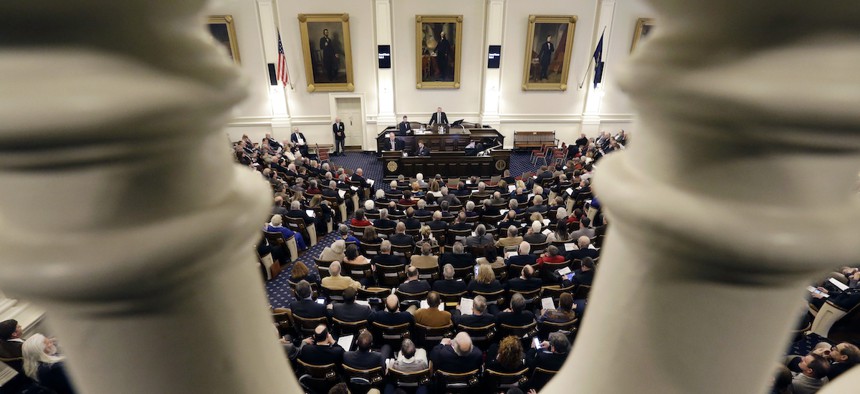Few Big Changes—But Lots of Newcomers—In State Legislative Elections

The New Hampshire House of Representatives, pictured here in 2017, flipped to Republican control in the 2020 elections. Associated Press
Voters elected roughly 1,500 new state lawmakers in last week's election, but only one state legislature flipped party control.
From governors’ mansions to legislative chambers, the story of partisan shifts in state government following last week’s election is ... not much of a story at all, said Tim Storey, executive director of the National Conference of State Legislatures.
“You have to be paying really close attention to see what changed,” Storey said Thursday during an NCSL webinar recapping the 2020 election results. “The big story here is that there was not a lot of change.”
Nearly 6,000 state legislative races were on the ballot last Tuesday, Storey said, but only two chambers—the New Hampshire House and Senate—flipped party control, both going to Republicans. Because Virginia’s House and Senate flipped to Democrats in 2019, the partisan makeup of the country’s state legislative bodies remains exactly where it was two years ago: 29 legislatures in the hands of Republicans, 19 under Democratic control, and one (Minnesota) divided. (The remaining state legislature—Nebraska’s—is nonpartisan.)
“There was no change in overall control in the last two-year election cycle, which has never happened before,” Storey said.
Individual chambers usually switch hands at higher rates as well. In a typical two-year election cycle, Storey said, an average of 12 chambers flip party control. This year, it’s just New Hampshire, and even that wasn’t much of a surprise.
“The New Hampshire legislature...has been the most competitive legislature over the past decade,” Storey said. “The New Hampshire House has changed party control in six of the last eight elections, and once again, this time, the Republicans took the majority. They now have over 215 seats in the 400-member state legislative house. The New Hampshire Senate is much smaller, and Republicans appear to have a one-seat advantage there.”
Governors’ races were similarly uneventful. Only 11 states voted for gubernatorial candidates, and only one—Montana—was considered competitive, Storey said. Republican Greg Gianforte won there with roughly 54% of the vote, flipping the governor’s mansion for the first time in 16 years. That’s noteworthy mostly because Montana’s legislature is also Republican, Storey said, giving the party a trifecta of power there.
With that win, Republicans hold total control—both chambers and the governor's mansion—in 24 states, compared to 15 for Democrats. There are also only a handful of states where one party holds a veto-proof majority in the state legislature, Storey added—Republicans in Kansas and Kentucky, and Democrats in Delaware.
The overall success of Republican candidates was somewhat surprising, Storey said. The 2020 election had been anticipated as a potential blue-wave year for Democrats after 2018, when the party flipped more than 350 seats in state legislatures nationwide. Instead, Republicans picked up around 160 seats.
“I think most people thought the Democrats had the wind at their backs and it was the Republicans playing defense,” Storey said. “If there was any surprise, it was that Republicans fared a little bit better than people had expected, and now they control close to 55% of all legislative seats.”
But even without shifts in chamber control, there was still a fair amount of change. Voters elected a minimum of 1,500 new state legislators, Storey said, and a handful of states are poised to also make changes in their House and Senate leadership roles. That, coupled with the first widespread legislative sessions during the ongoing pandemic, could signal an interesting year for state lawmakers.
“I think what we will see in January and February when most states come into session is, you know, limited access to state capitols. You will see them going to other venues,” Storey said. “It’s going to be an unusual session.”
Kate Elizabeth Queram is a staff correspondent for Route Fifty and is based in Washington, D.C.
NEXT STORY: Most States Aren’t Ready to Distribute the Leading COVID-19 Vaccine





